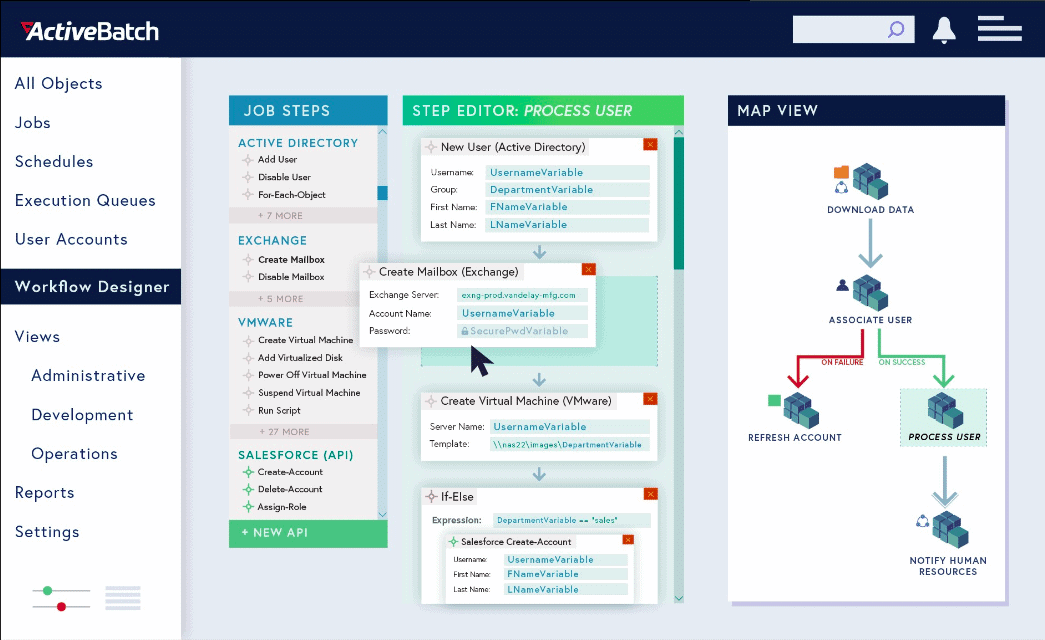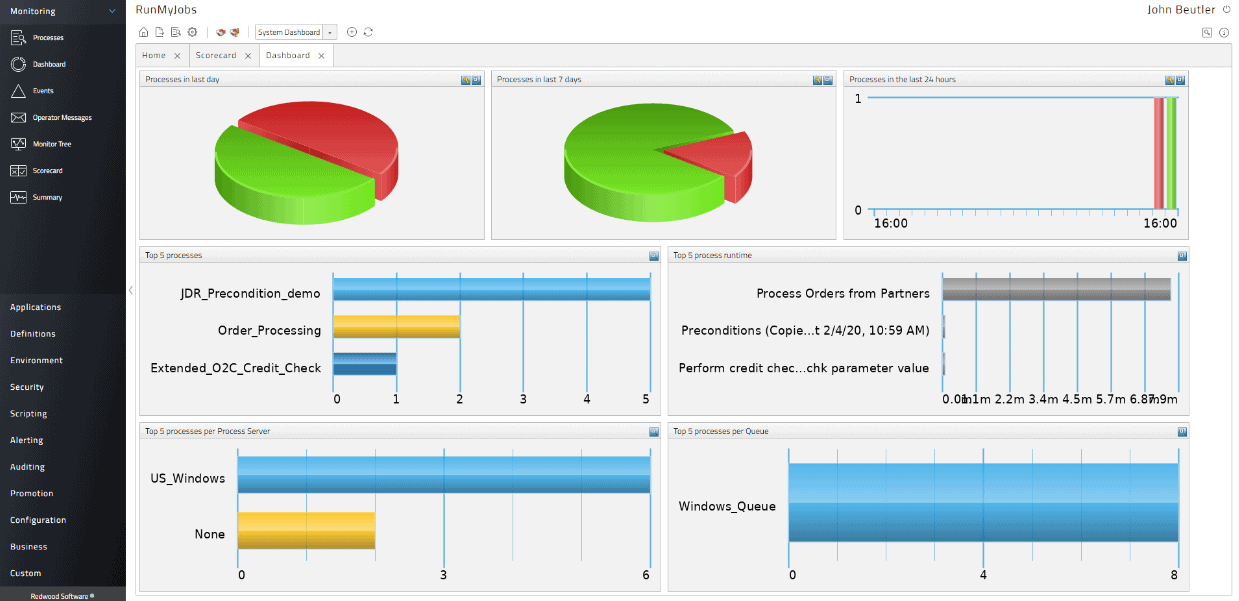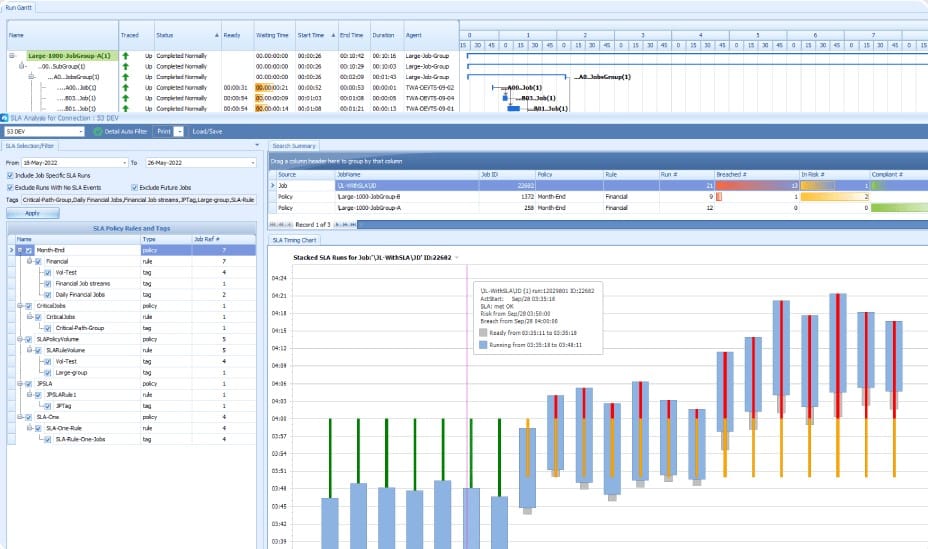Our funding comes from our readers, and we may earn a commission if you make a purchase through the links on our website.
The Best AutoSys Alternatives
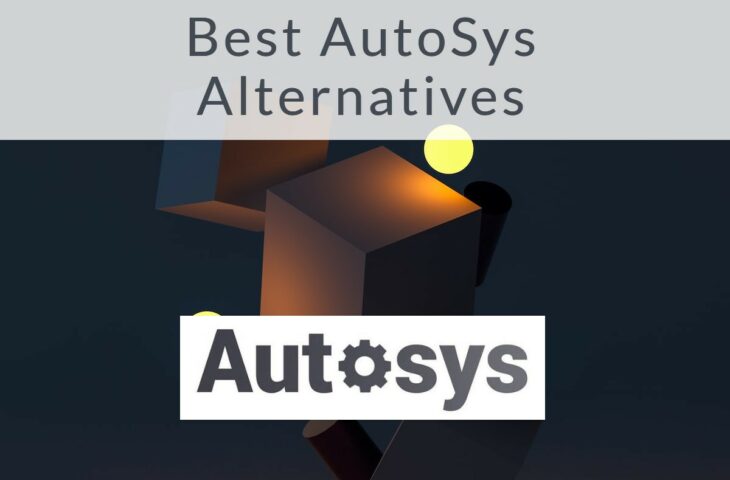
UPDATED: October 26, 2023
Getting deeper visibility into complex workloads spread across the cloud, ERP systems, and other platforms and managing them efficiently can be really challenging for businesses. That’s where AutoSys comes in!
AutoSys is an exceptional solution for workload automation and job scheduling.
Here is a list of our best AutoSys Alternatives:
- ActiveBatch – EDITOR'S CHOICE This cloud-based job scheduling package provides the capability to organize existing software into a coordinated platform by launching programs in sequence in a similar manner to a batch file. The service includes a scheduler that enables you to run entire process flows without human intervention out of hours. You can get a demo and then follow up with a free trial.
- Redwood – GET FREE DEMO A SaaS system that can schedule tasks through a graphics-driven workflow editor and manage complicated data exchanges, such as security and ERP data flows.
- Tidal Workload Automation – GET FREE DEMO A software coordination platform that orchestrates the movement of data between them and re-formats records where necessary.
- Stonebranch A cloud base workload automation service that implements tasks automation through batch file creation and execution.
- Control-M A task automation service that operates through batch jobs to move data and services through a pipeline. This cloud0-based service is great for DevOps environments.
- Ansible A Linux-based software package from Red Hat that is a very good system for managing the gathering and management of data for system security tools.
- Activeeon An API-based system that offers access to a cloud-hosted library of scheduling functions.
- JAMS A cloud-based scheduling system that supports the assembly of batch jobs and the management of their execution.
- Opcon An on-premises package that offers a batch job creation utility that also schedules those batches for timed execution. Installs on Windows Server.
It provides greater control and visibility into diverse enterprise workloads. This in return reduces costs as well as simplifies management of business-critical processes. You can deploy it On-premises, in a public, private, or even in a hybrid environment. For overdue jobs, AutoSys offers automated actions, notifications, and forecasting.
The key highlights of AutoSys are multi-platform scheduling, built-in fault tolerance, security and compliance, scalability, and self-service.
Why Do You Need to Look for AutoSys Alternatives?
AutoSys comes with myriads of M&A (mergers and acquisitions) and future releases, thereby confusing the end-user about the support they could get for the same. By the same token, the response times are supposedly longer making AutoSys quite unreliable.
While a few services are free to use, some other tools require you to avail them of their expert onboarding and training for additional guidance. You can connect the system to any service, server, or application to scale automation. But the support AutoSys offers for this feature is quite poor when compared to other tools. On the other hand, timely health checks and proactive support from tech experts is lacking.
Seeing all these downsides, here we have put together reviews of the best AutoSys Alternatives you could opt for.
The Best AutoSys Alternatives
Our methodology for selecting Autosys alternatives
- We reviewed various Autosys alternatives and analyzed the options based on the following criteria:
- A facility to analyze network performance over time
- Graphical interpretation of data, such as charts and graphs
- A free trial period, a demo, or a money-back guarantee for no-risk assessment
- A good price that reflects value for money when compared to the functions offered
1. ActiveBatch – FREE DEMO
ActiveBatch is one of the best AutoSys Alternatives. It is an all-in-one solution for centralized workload automation and job scheduling. It effectively orchestrates your entire tech stack by leveraging no-code connectors and a low-code REST API adapter.
Key Features:
- ActiveBatch features flexible UIs (User Interfaces) with robust ready-to-use functionalities and customization abilities. You can access ActiveBatch from any device.
- Job scheduler helps you create and orchestrate cross-functional workloads. It effectively manages scheduling, balancing, reporting, dependency checking, and notifications.
- It connects to any application, service, or server so as to orchestrate workloads across your entire tech stack.
- The extensible and flexible REST API adapter allows you to create secure connections with any service or tool with an API, thereby expanding automation to various endpoints.
- It offers hundreds of connectors to commonly-used systems
- ML models analyze historical data of instances and extract predictions for dynamic resource allocation.
- Change management tools help you easily shift workflows between Dev and Production.
- It redirects jobs and plans to standby systems in case of power failure or potential outages for high availability.
- With role-specific views, every team can extract metrics that matter to them. Map View helps developers to create and optimize workflows, whereas Operations View displays job status and progress.
- Self-service portals equalize automation across IT as well as for the user community
- Offers various auditing & compliance capabilities such as policy authorizations, auditing, revision history, and advanced SLA management.
ActiveBatch offers wide-ranging extensibility as it can connect to any application, any server, or any service, thus offering numerous endpoints. With a robust Job Step library and myriads of drag-and-drop actions, you can seamlessly build personalized end-to-end processes. Besides, it offers proactive support, self-healing features, and in-app KB (knowledgebase) to make it more reliable.
ActiveBatch acts as a centralized automation hub for monitoring and scheduling, in order to make various business-critical systems such as BI, CRM, ETL tools, project management, Big Data, ERP, work order management, and consulting systems seamlessly work together without much human interference.
Pros:
- Centralized automation for all your tools in one place
- Uses a simple drag-and-drop interface to build workflows
- Highly customizable automation, workflows, and scheduling options
- Scales well with enterprises and with growing organizations
Cons:
- Although ActiveBatch is easy to use, the platform has many features that require time to fully explore
You can register for a free demo.
Website Link: https://www.advsyscon.com/en-us/activebatch/
EDITOR'S CHOICE
ActiveBatch is our top pick for an AutoSys alternative because it is hosted in the cloud as a SaaS package, so you don’t need to host or maintain its code. This system is able to run software that is hosted on different servers within the same batch and they can even by operating in the cloud. The tool cuts the cost of managing a team of data entry clerks by processing data through several software packages and removing manual data entry tasks. That benefit also removes human error. AutoSys provides a way to manage resources and perform maintenance tasks as well. The scheduler means that you can move a lot of IT activity out of hours and thus lighten the burden on your network and other IT assets.
Download: Get FREE Demo & Trial
Official Site: https://www.advsyscon.com/en-us/demo/quick
OS: Cloud-based
2. Redwood RunMyJobs – GET FREE DEMO
Redwood offers power-packed SaaS-based business process automation based on real-time events. Build intelligent, reusable business processes with flexible drag-and-drop UI and low-code graphical editors containing a wide-ranging library of wizards and templates. Each process is made up of individual tasks and it is possible to schedule processes to run in parallel.
Key Features:
- Prebuilt connectors for S/4HANA, BTP and other SAP solutions enables speed to market and keeps clean core
- Features customizable branching paths and preconditions that are status-based, which helps you build intelligence into your business-critical processes.
- Multi-tier environments allow for individual development, production, and testing. Besides, you can easily promote between these environments.
- For complete lifecycle management of your business processes, it integrates source control, rollback, and audit trails.
- Control flow of existing and future processes by setting flags based on execution results.
- With branching paths, you can repeat or skip steps, trigger processes or take critical actions.
- Orchestrate processes and data pipelines right when the files or data are available.
- Make sure data is complete by verifying record counts, size, timestamps, wildcard name pattern matches, etc., and then start processes.
- For real-time, seamless orchestration, it can trigger and start other processes based on custom events.
- With dynamic workload balancing, you can easily prioritize and balance process capacity to enhance throughputs.
- Data-driven and event-based orchestration provide accurate and complete data to teams.
- Inbuilt SLA monitoring helps businesses meet SLA standards and get alerts when deadlines seem to slip.
- Powerful process automation features allow you to build complex schedules easily.
- Contains ready-to-use schedules and a library of patterns.
- With full-time zone support, you can automatically schedule jobs across multiple time zones.
- Reusable process steps, calendars, sequences, and other elements discard the need for unnecessary duplications. This reduces errors and promotes consistency.
- Update tasks once and apply them everywhere.
- Get real-time insights into the status and performance of individual processes and business-critical systems.
- Customizable dashboards and role-specific or user-specific views allow you to derive metrics that matter the most.
- Intelligent self-remediation tools reduce human intervention and make processes more resilient.
- Get alerts through SMS, email, or apps including Slack and Microsoft Teams.
- Integrated report builder helps you build and publish comprehensive ad-hoc and scheduled reports.
- Out-of-the-box connectors included automating any application.
The best thing about Redwood is that it offers support for over 25 scripting languages and UIs including PowerShell, Python, and R with built-in parameter replacement and highlighting features.
We chose Redwood RunMyJobs because it will generate batch scripts from a graphical interface and can create those scripts in 25 languages. The system will also supervise the operations of those scripts, which can be set to trigger on an event or be launched from a schedule. The scripts can be stored with variables for parameters, creating a library of functions that can be reused for other batch job requirements.
Pros:
- Simple easy to use interface
- Integrates with a wide variety of applications, including ERP systems
- Can implement traffic shaping rules to the job (great for high-priority tasks)
- Consumption-based pricing makes RunMyJobs accessible to any size business
Cons:
- Designed for IT professionals, not the best fit for non-technical users
Get FREE Demo: https://www.redwood.com/lp/ex0/ca-autosys
3. Tidal Workload Automation – GET FREE DEMO
Tidal Workload Automation lets businesses create automatic coordination between software packages from different suppliers as though they were operating on a common platform. This system includes integrations with many third-party systems so that it can run them and extract data to pass on to the next package in the chain.
Key Features:
- Supports the creation of data flows around an organization
- Removes the need for manual data entry
- Creates a sequence of software packages
- Will trigger a workload when a specific event occurs
- Operates a schedule into which workloads can be loaded
- Coordinates the actions of software packages on different platforms
- Can manage software on-site, on remote sites, or on the cloud in one workflow
- Can launch different software packages depending on the outcome of a previous step in the workflow
- Suitable for the creation of a CI/CD pipeline in DevOps software management
- Good for managing data flows into or out of ERPs
- Can implement external notifications by email or social media
Tidal can be used for many different purposes. It is frequently used to validate inputs to ERP systems and also to extract ERP data for use in third-party software packages.
The Tidal Workload Automation package is a good choice for system verification procedures, such as the enforcement of best practices and standards compliance. The system can be linked to contract management services to enforce service level agreements (SLAs) and check invoices. The system can also be used for financial management tasks, such as bank reconciliation.
Pros:
- Crosses platforms within a single workload
- Implements data verification and process controls
- Allows conditions branching according to stage completion statuses
Cons:
- No free trial
You can access a free demo.
Website Link: https://www.tidalsoftware.com/workload-automation/tidal-automation/
4. Stonebranch
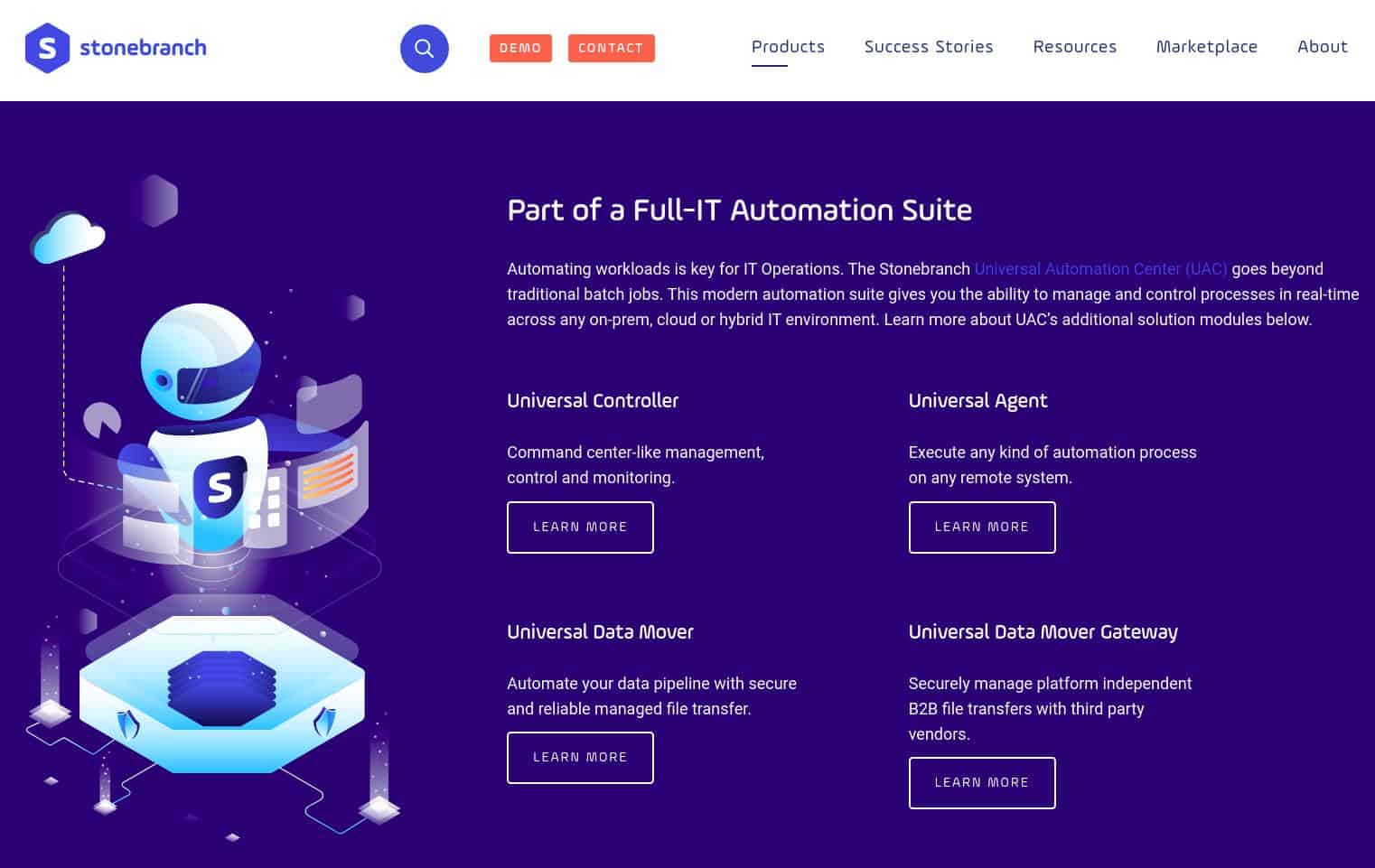
Stonebranch is a capable, flexible, and reliable AutoSys Alternative that centralizes control and breaks down hybrid automation silos, right from containerized microservices, to cloud and on-premises. It is an all-in-one solution that meets business needs, is event-based, runs in the cloud or on-premises, and reduces human oversight.
Key Features:
- WLA (Workload Automation) not only provides advanced control over workloads across different IT platforms but also helps you create intelligent workflows as per event-based triggers.
- Through a single controller, IT leaders can manage automation across all mainframes, cloud service platforms, and on-premises servers.
- Connects across the entire tech stack to help you create cross-platform workloads with the help of visual drag-and-drop tools.
- Orchestrate, automate and manage IT processes, regardless of where the data is stored.
- DevOps ready solution is ideal to deliver jobs-as-code
- Integrates with any application or platform. Comes with pre-packaged integrations and also allows you to build customized integrations. Moreover, you can even download integration blueprints from the open-source Stonebranch Marketplace that is driven by the user community.
- User interface with self-service functionality allows you to install and upgrade systems with minimal effort.
- Visual dashboards along with drill-down reports help you with SLA monitoring, real-time insights, and status related to all your operations.
- It is a powerful hybrid IT automation solution for cloud service automation, workload automation, hybrid cloud file transfers, DevOps orchestration, and Big Data pipeline orchestration.
Stonebranch offers robust Enterprise Job Scheduling software to automate various IT tasks and business processes at regular intervals.
Stonebranch UAC (Universal Automation Center) is a high-grade, event-based workflow automation solution that automates and orchestrates system tasks and jobs across on-premises, all mainframe, and hybrid IT platforms. With this tool, IT Ops teams can get deeper visibility and enhanced control through a single robust console.
Pros:
- Supports cloud, multi-cloud, and on-premise automation
- Easily switch automation on or off and create chains of automation across your environment
- Does a great job of centralizing your automation even across more complex networks
Cons:
- Could benefit from more multi-tenant features
Website Link: https://www.stonebranch.com/
5. Control-M
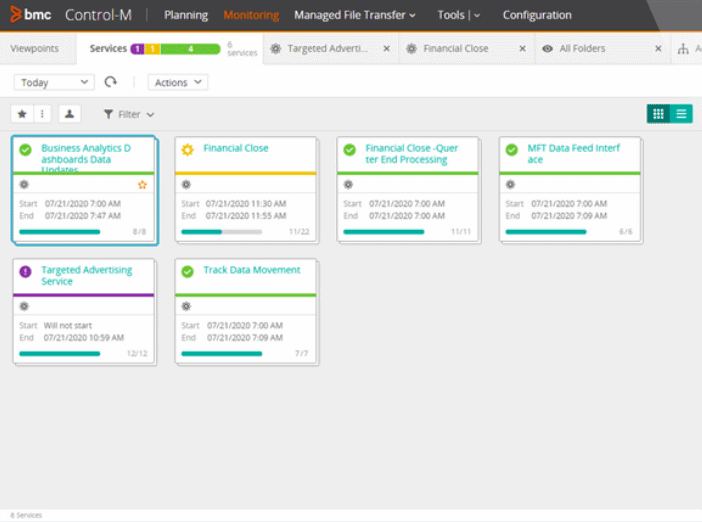
Control-M is one of the best AutoSys Alternatives for the orchestration of complex application workflows.
It considerably simplifies data and application workflow orchestration as a service or on-premises. Businesses can easily define, build, schedule, manage and monitor business-critical workloads to get deeper visibility whilst enhancing SLAs. With its innovative Jobs-as-Code approach, you can seamlessly scale collaboration between the Dev and Ops team.
Key Features:
- Embed workflow orchestration right into your CI/CD pipeline and speed up delivery of new business applications.
- A data-driven approach helps you accelerate and manage big data workflows.
- Intelligent file movement and visibility features provide you full control over your file transfer operations.
- Connects to any data source, application, and critical systems right from the cloud to the mainframe.
- Intelligent predictive analytics tools help you achieve proactive SLA management.
- Offers solid support for governance, compliance, and audits.
- REST APIs and JSON promote the Jobs-as-Code approach and thereby accelerate the process of application development, testing, and validation times.
- Find problems and bugs way early in the software development lifecycle to reduce costs and enhance quality.
- Get a 360-degree, deeper view into data pipelines right from their ingestion stage to processing and analytics.
- Ingest and process data from Spark, EMR, Hadoop, Snowflake, and RedShift platforms.
- Provides out-of-the-box support for Step Functions and Batch, AWS Lambda, Azure Logic Apps, Functions, and Batch.
- Quickly move external and internal file transfers from a central UI.
Important point is that it simplifies workflows across multi-cloud and hybrid environments with its robust Azure, GCP (Google Cloud Platform), and AWS integrations.
Pros:
- Highly customizable tasks, dashboard, and scheduling features
- Supports multiple operating systems such as Linux, Windows, and macOS
- Uses a simple yet informative dashboard for monitoring
Cons:
- Would like to see more workflow visualization options
- Not the best fit for non-technical users
Website Link: https://www.bmc.com/it-solutions/control-m.html
6. Ansible
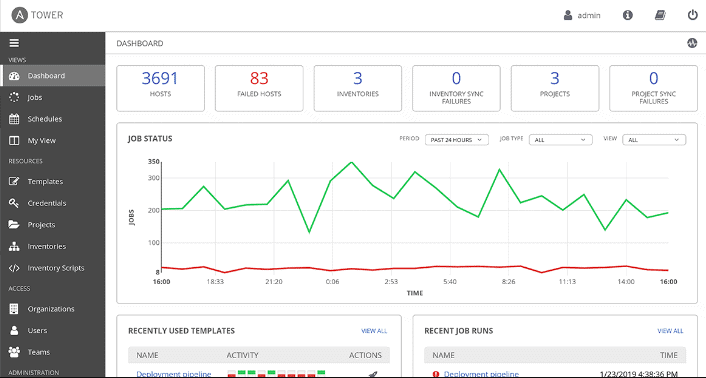
Ansible is an all-inclusive AutoSys Alternative that drives automation across all your open hybrid cloud environments. It drives agentless IT workload automation by turning complex tasks into repeatable playbooks. With just a click of a button, the powerful tool can roll out protocols across your entire enterprise.
Key Features:
- Offers robust infrastructure and application automation capabilities.
- Also offers container automation abilities with native Kubernetes management which further extends to Red Hat OpenShift Container Platform and other container technologies.
- Modernize service processes by automating actions on service requests and creating a single source of truth for your IT asset configurations.
- Integrations are available for various infrastructures including HPE, VMware, ServiceNow, Red Hat, Windows, IBM Power Systems, and more.
- Deploy multi-tier applications from a single framework.
- Write repeatable and reliable “Playbooks” viz. descriptions of the desired system state. Ansible tools strive to make your systems reach this desired state.
- Has a huge library of building blocks to help you manage various IT tasks and network software.
- The cloud-ready solution can interact with Microsoft Azure, Amazon AWS, etc.
Ansible automates processes across containerized workloads and private clouds (physical and virtual endpoints). Businesses can easily manage and provision storage devices, bare-metal servers, and network devices, and more. The Playbook-based automation is easy to use and seamlessly integrates into your existing provisioning infrastructure.
Apart from physical devices, Ansible also robustly supports automation for industry-leading virtual platforms such as Red Hat Virtualization, Vagrant, and VMware vSphere. You can easily provision, take inventory, discard and manage these virtual environments like a pro.
Pros:
- Excellent interface provides high-level insights and easy-to-access details
- Displays and tracks workflows and offers intuitive task scheduling
- Great for collaboration, supports notifications as well as integrations into messaging platforms
- Great options for both small and large dev teams
Cons:
- Offers many different options which can take some time to fully explore
Website Link: https://www.ansible.com/
7. Activeeon
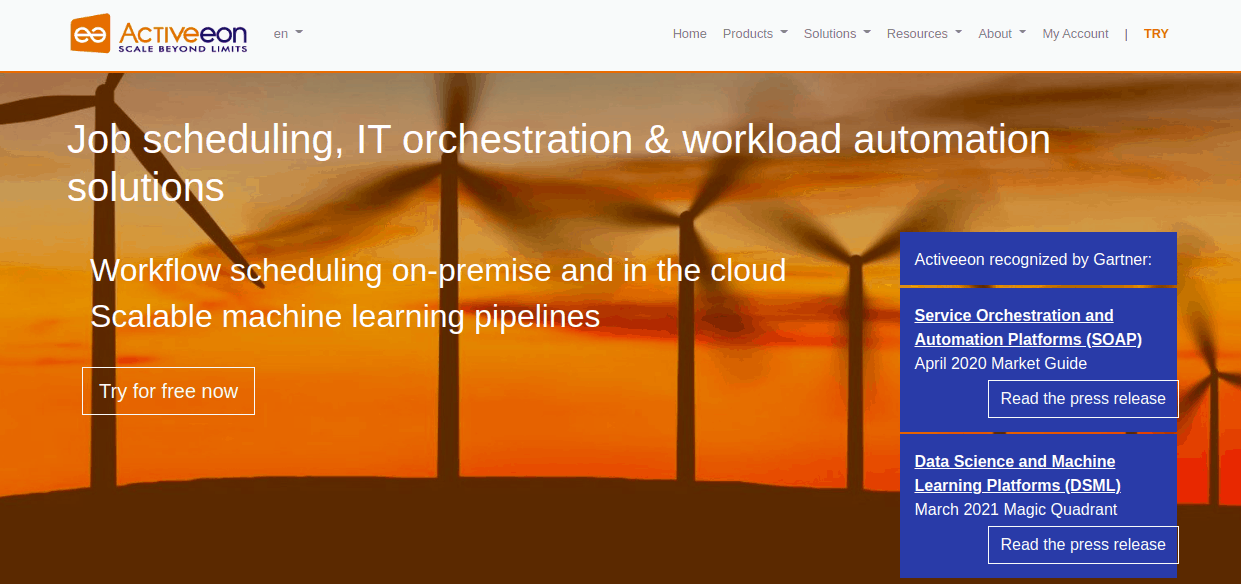
Another feature-packed AutoSys Alternative we have here is Activeeon, which is great for workload automation as well as orchestration of scalable ML pipelines.
Key Features:
- Manage workloads on multi-cloud and hybrid environments and configure flexible policies.
- Enhanced governance and control with inbuilt features for notifications, error management, ease of operations, file handling, connectors, docker support, and more.
- Automate and schedule jobs and tasks on any infrastructure.
- Easily manage a large production environment with numerous scripts, ETL jobs.
- Integrate with any environment as it is an open, API-first platform.
- Deploy and parallelize heavy workloads on large-scale production infrastructure.
- Deploy and scale Machine Learning workflows on any infrastructure (local, multi-cloud, and hybrid).
- Offers automation for ML Dev lifecycle.
It can automate and schedule workflows at any scale, be it in the cloud or on-premises. Through a single-pane-of-glass, businesses can control all processes and eliminate silos with a flexible, cross-platform unified automation solution.
Pros:
- Supports customs workflow builds that allow you to build off templates
- Offer numerous notification options
- Can automatically assign workflows to new devices without configuration
Cons:
- More complex automation features might be too much for smaller organizations
Website Link: https://www.activeeon.com/
8. JAMS
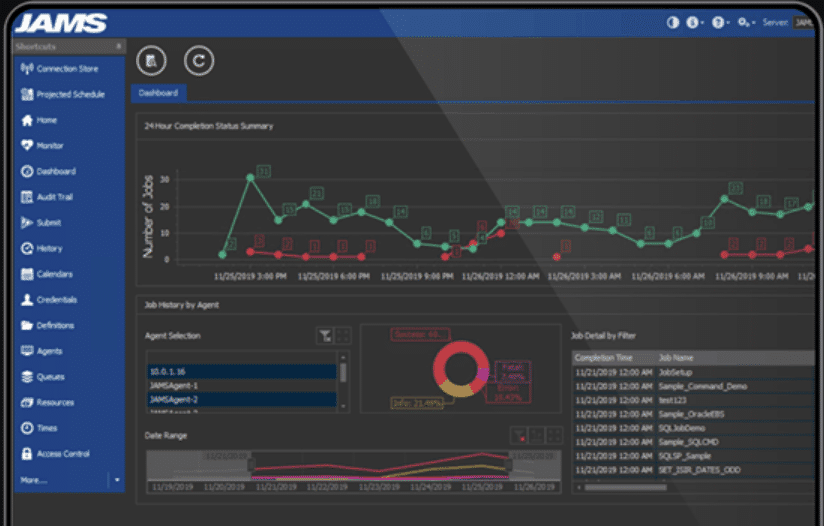
JAMS is an excellent enterprise-grade workload automation solution that effectively manages your business processes – right from simple batch processes to cross-platform complex workloads that integrate jobs from multi-tier applications and servers.
With JAMS Job Scheduler, you can define, schedule, run and monitor jobs and tasks through a single console. It can automate jobs on UNIX, Linux, Windows, IBM, OpenVMS, and zOS. Besides, it also includes native integrations for applications to run jobs and tasks that are exclusive to ERP systems, BI tools, or databases.
Key Features:
- Jobs Scheduler consistently checks whether all conditions are met, evaluates job definitions, and sends them forward for execution.
- Job Scheduler can carry out Batch Processing – meaning it can run sets of jobs simultaneously to reduce business interruptions.
- In case of an outage, it mirrors all resources required to run jobs to boost high availability
- Allows you to execute jobs based on days, dates, regular times, etc.
- The job Triggering feature lets you run jobs based on irregular events such as change of a variable, file receipt, and so on.
- Access Manager will impose security rules on the Job Scheduler and its every job. These rules will determine who gets to create, edit and submit jobs to the schedule.
- Comes with a standardized library of job definitions containing inherited access controls along with comprehensive version control.
- Allows you to define security roles so that you can assign the granular rights to the optimal user.
- Track the progress and status of every automated job and consolidate individual jobs’ log into various views to get insights.
- Intuitive dashboards contain charts, graphs, and visualizations that show job information along with historical and infrastructure data.
- Get alerts on significant events related to automated jobs.
The software has an extensive range of automation features to help you run jobs on any schedule, monitor their status, and send alerts in case of failures. It maintains a detailed audit trail and logs for each execution, along with triggering off the completion of events.
Pros:
- Excellent workflow and data visualizations
- Easy to track assets across multiple workflows
- Designed with enterprises in mind (ERP support, etc.)
Cons:
- Smaller organizations might not benefit from all of JAM Schedulers options
Website Link: https://www.jamsscheduler.com/
9. Opcon
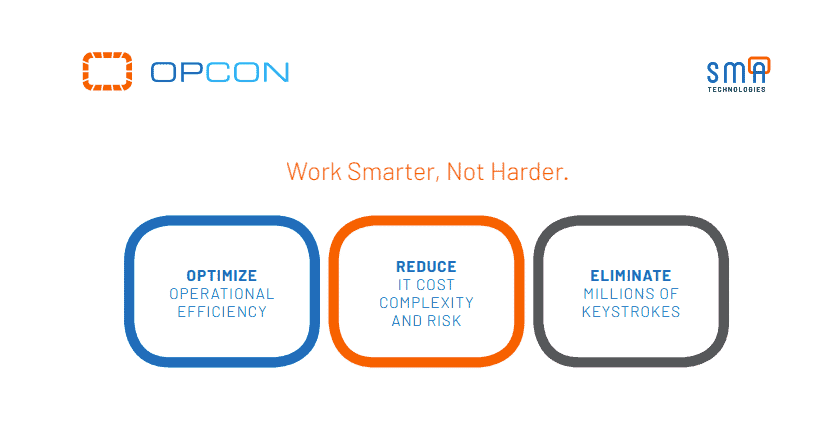
Opcon is another flexible and feature-packed platform that scales with business to automate and manage numerous jobs across multiple OS and environments.
Key Features:
- Allows quick interactions with connectors for Correlation, Fiserv, and Symitar.
- Offers self-service automation.
- Detect new files and automate schedules.
- Get real-time, deeper visibility and maintain an audit trail for every job.
- Get enhanced governance and security over workflows.
- Automate disaster recovery.
- Integrates with the most applications, ERP, and OS.
With a seamless migration framework, you can switch from old platforms by leveraging REST API, a vast library of legacy connectors, and industry-leading expertise.
Pros:
- Offers automation migration services – great for complex and critical workflows
- Includes disaster recovery testing
- Focuses on reducing complexity across enterprise automation
Cons:
- Caters to enterprise networks – not the best fit for smaller networks
- Would like to see a free trial version for testing
Website Link: https://smatechnologies.com/products-opcon-automation
Conclusion
Workload automation solution acts as a central hub of automation for scheduling and monitoring business processes. With robust workload automation solutions, business processes such as ETL tools, ERP, project management, etc. can work together in a streamlined manner with minimal human intervention.
Best workload automation is the one that scales easily and is capable enough to grow as per the business requirements. Another crucial factor that you must consider when choosing a workload automation solution is the support it provides. Solid support makes the tool reliable and eases the onboarding process. AutoSys lacks Proactive Support and REST API adapters.
Hope this detailed review on the best AutoSys Alternatives will help you choose your right kind of tool for workload automation. All of the tools mentioned here are capable enough to automate and schedule business workflows across your entire tech stack while overcoming the cons of AutoSys.
AutoSys Alternatives FAQs
What is AutoSys?
AutoSys is an enterprise job scheduling software solution that provides tools for automating and managing business processes and workflows. AutoSys is designed to support complex, distributed, and cross-platform environments and provides job scheduling, event-driven processing, and centralized monitoring and control.
What are some alternatives to AutoSys?
Some popular alternatives to AutoSys include:
- Redwood: A SaaS workload automation solution with a simple yet powerful graphical editor for ERP dataflows.
- Control-M: A workload automation and job scheduling software solution that provides tools for managing and automating business processes and workflows. Control-M is designed for enterprises and provides support for multiple platforms and technologies.
- IBM Workload Scheduler: A job scheduling software solution that provides tools for automating and managing business processes and workflows. IBM Workload Scheduler is designed for enterprises and provides support for multiple platforms and technologies.
- CA Workload Automation: A job scheduling software solution that provides tools for managing and automating business processes and workflows. CA Workload Automation is designed for enterprises and provides support for multiple platforms and technologies.
- Ansible: An open-source automation software solution that provides tools for automating IT workflows and processes. Ansible is designed for IT professionals and provides support for multiple technologies and platforms.

